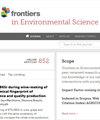Advancing towards a low-carbon urban future in China: the role of producer services agglomeration
IF 3.3
3区 环境科学与生态学
Q2 ENVIRONMENTAL SCIENCES
引用次数: 0
Abstract
The reduction of greenhouse gas emissions is a shared challenge encountered by nations worldwide. As China is on its way toward a green economy, it is worth studying whether producer services agglomeration, a key driver of economic transition, can promote low-carbon urban development. Using panel data of 257 cities across China from 2006 to 2019, this paper examines the influence of producer services agglomeration on urban carbon emissions with spatial econometric models. The findings reveal a positive spatial correlation in regional carbon emissions. The agglomeration of producer services notably decreases the intensity of local carbon emissions, yet it appears to have minimal influence on the emissions from adjacent regions. Enhancing energy efficiency and adjusting the industrial structure are two critical mechanisms by which producer services agglomeration reduces urban carbon emissions. This beneficial effect varies with city type, the abatement effect of producer services agglomeration is more pronounced in non-resource-based cities. When considering city size, the carbon reduction potential of producer services agglomeration is not apparent in smaller cities. As city size increases, the emission reduction effect becomes more apparent. However, in mega-cities, this impact is somewhat diminished. Accordingly, this paper proposes exploring methods of coordinated air pollution management across cities, promoting producer services agglomeration in line with market mechanisms, and driving low-carbon urban development in a manner tailored to local conditions.中国城市迈向低碳未来:生产者服务集聚区的作用
减少温室气体排放是世界各国共同面临的挑战。在中国迈向绿色经济的道路上,生产性服务业集聚作为经济转型的重要驱动力,能否促进城市低碳发展值得研究。本文利用 2006 年至 2019 年中国 257 个城市的面板数据,通过空间计量经济模型研究了生产者服务业集聚对城市碳排放的影响。研究结果表明,区域碳排放存在正空间相关性。生产性服务业集聚显著降低了当地的碳排放强度,但似乎对相邻地区的碳排放影响甚微。提高能源效率和调整产业结构是生产者服务业集聚减少城市碳排放的两个关键机制。这种有利效应因城市类型而异,在非资源型城市,生产者服务业集聚的减排效应更为明显。如果考虑城市规模,生产者服务业集聚的碳减排潜力在规模较小的城市并不明显。随着城市规模的扩大,减排效应会更加明显。然而,在特大城市,这种影响会有所减弱。因此,本文建议探索跨城市大气污染协同治理的方法,按照市场机制促进生产者服务业集聚,因地制宜地推动城市低碳发展。
本文章由计算机程序翻译,如有差异,请以英文原文为准。
求助全文
约1分钟内获得全文
求助全文
来源期刊

Frontiers in Environmental Science
Environmental Science-General Environmental Science
CiteScore
4.50
自引率
8.70%
发文量
2276
审稿时长
12 weeks
期刊介绍:
Our natural world is experiencing a state of rapid change unprecedented in the presence of humans. The changes affect virtually all physical, chemical and biological systems on Earth. The interaction of these systems leads to tipping points, feedbacks and amplification of effects. In virtually all cases, the causes of environmental change can be traced to human activity through either direct interventions as a consequence of pollution, or through global warming from greenhouse case emissions. Well-formulated and internationally-relevant policies to mitigate the change, or adapt to the consequences, that will ensure our ability to thrive in the coming decades are badly needed. Without proper understanding of the processes involved, and deep understanding of the likely impacts of bad decisions or inaction, the security of food, water and energy is a risk. Left unchecked shortages of these basic commodities will lead to migration, global geopolitical tension and conflict. This represents the major challenge of our time. We are the first generation to appreciate the problem and we will be judged in future by our ability to determine and take the action necessary. Appropriate knowledge of the condition of our natural world, appreciation of the changes occurring, and predictions of how the future will develop are requisite to the definition and implementation of solutions.
Frontiers in Environmental Science publishes research at the cutting edge of knowledge of our natural world and its various intersections with society. It bridges between the identification and measurement of change, comprehension of the processes responsible, and the measures needed to reduce their impact. Its aim is to assist the formulation of policies, by offering sound scientific evidence on environmental science, that will lead to a more inhabitable and sustainable world for the generations to come.
 求助内容:
求助内容: 应助结果提醒方式:
应助结果提醒方式:


